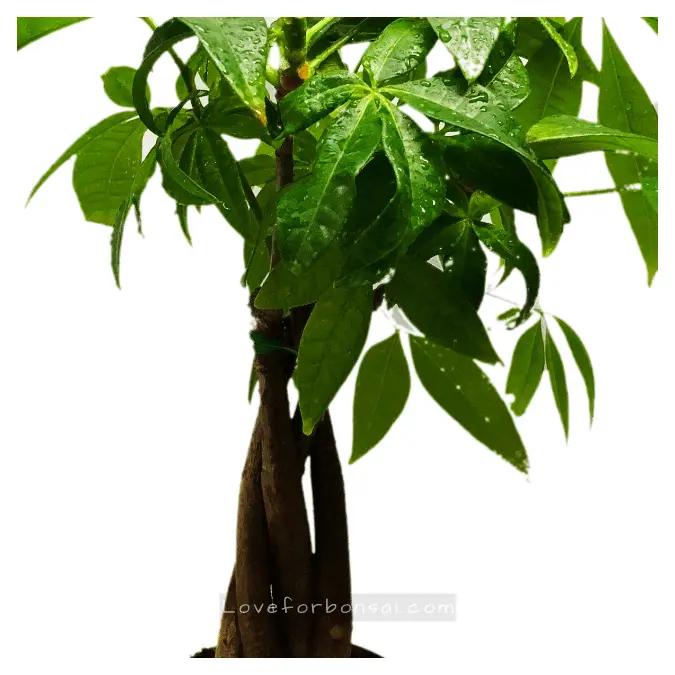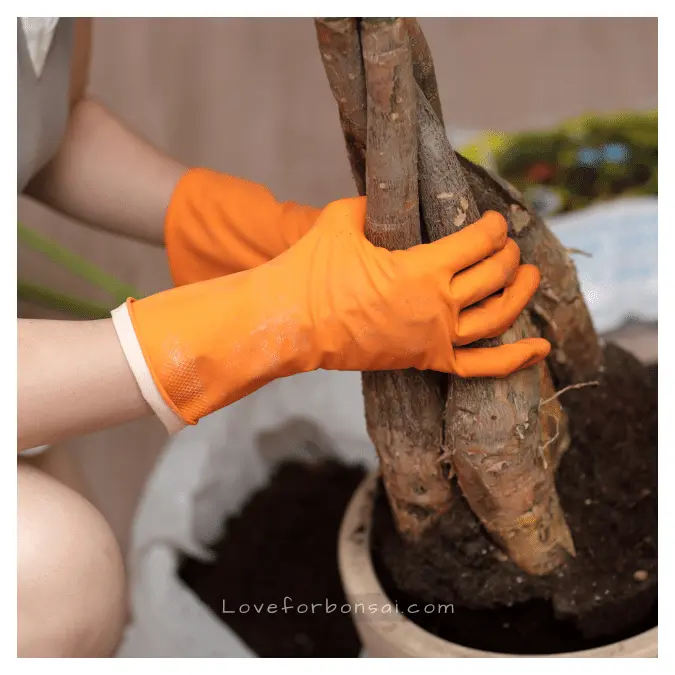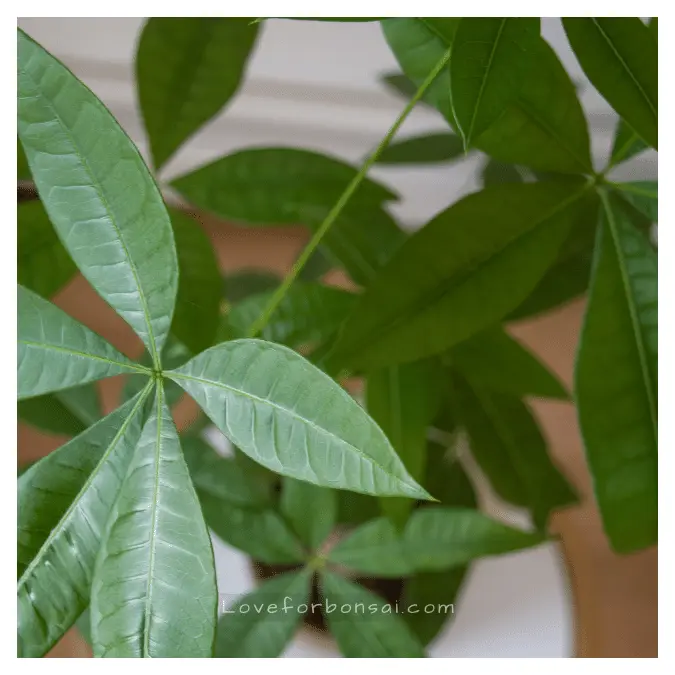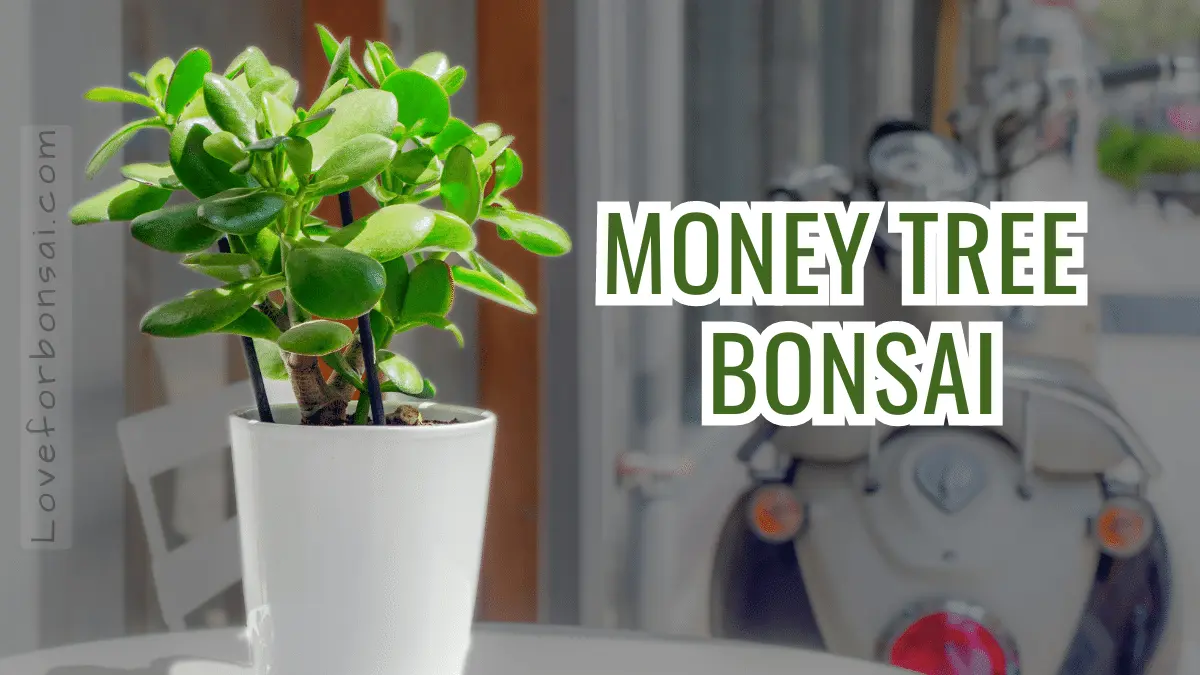Do you want to invite a touch of natural serenity and good fortune into your home? Have you considered the bonsai money tree, with its intricate braided trunk and lush canopy of symbolic leaves? Caring for this living art develops patience and a connection with nature’s cycles.
Read on to master the skills of watering, wiring, troubleshooting, and displaying your miniature money tree to cultivate its full potential.
We’ll explore simple propagation methods, styling techniques, and more so you can grow and shape your own bonsai filled with personal meaning.
A Brief History of Money Tree Bonsai
Bonsai is the ancient technique of artistically growing miniature trees in containers. It originated in China over a thousand years ago, later spreading to Japan and the rest of the world. The goal of bonsai is to replicate aged, full-sized trees by pruning roots and branches, and using other careful styling techniques.
The botanical name of the money tree is Pachira aquatica. It is native to Central and South America. It’s a tropical wetland tree that can grow up to 60 feet tall outdoors but is more commonly grown as a houseplant. Its braided or unbraided trunks sprout five or more palmate leaves, resembling an open hand.
Money trees are highly symbolic, associated with good Feng Shui, and believed to bring prosperity and luck. Combining this mystical plant with the art of bonsai creates a living sculpture that retains its cultural meaning in miniature form. Bonsai money trees are popular for decorating homes and offices.
Caring For Your Bonsai Money Tree
While pachira bonsai have some unique care needs, their requirements closely align with taking care of regular money tree houseplants. Follow these tips to keep your miniature money tree happy and healthy:
Providing the Right Light
- Money trees thrive in relatively bright, filtered light indoors. Some direct morning or evening sun is beneficial.
- Avoid placing them in harsh midday light, which can scorch leaves. Filter sunlight with a sheer curtain if needed.
- If indoor light is low, situate your bonsai close to a bright southern or eastern window for adequate light exposure.
- During darker winter months, you may need to supplement natural light with a grow light for 12-14 hours per day.
- Rotate your tree periodically so all sides get equal lighting and grow evenly.

Watering Appropriately
- Money trees prefer infrequent but deep watering, allowing the soil to partially dry out between waterings.
- Water thoroughly until it drains from the bottom holes of the pot, then empty the drainage tray.
- Take care not to overwater, as soggy soil leads to root rot. Drooping leaves indicate under-watering.
- Mist the leaves occasionally to increase humidity around your bonsai.
- In winter when growth slows, reduce watering frequency to avoid over-saturation.
Applying Fertilizer
- Use a balanced liquid fertilizer diluted to half strength every 2-4 weeks during the active growing period.
- Organic or chemical fertilizer options both work well. Follow label directions.
- Avoid over-fertilizing, as excess salts can burn the plant’s roots.
- In fall and winter, reduce or eliminate fertilizer as growth naturally slows.
- For a naturally enriched soil mix, you can amend it with compost or worm castings.
Pruning for Shape
- Prune off any dead or diseased leaves, stems, and branches as needed.
- Pinch back new shoot tips to encourage bushier, compact growth.
- For formal upright and other shaped styles, prune strategically to guide the silhouette.
- Make pruning cuts just above leaf nodes or buds using clean, sharp shears.
- Disinfect your pruning tools between cuts to prevent disease spread.
- Take care not to over-prune. Allow new shoots time to extend and fill in.
Wiring Branches
- Gently bend pliable branches into position, adding bonsai wire for support.
- Wrap wounded areas with raffia tape to protect the bark from wire damage.
- Monitor wired branches closely. Reposition or remove wires gradually as needed.
- Leave wire in place 6-9 months until branches hold their shape, then remove carefully.
- Wiring takes practice and patience! Work slowly and follow each branch’s natural tendencies.
Preventing Pests and Diseases
- Inspect regularly for common pests like spider mites, scale, or mealybugs.
- Isolate and treat infestations early using neem oil, insecticidal soap, or other organic sprays.
- Improve airflow and reduce crowded conditions to deter pests.
- Gently wipe leaves with a damp cloth to remove dust buildup.
- Ensure proper care and avoid stress to prevent diseases. Disinfect tools between uses.
- Remove infected plant matter promptly to avoid spread.
Repotting for Fresh Soil

- Repot your money tree bonsai every 2-3 years in early spring.
- Carefully remove from the pot and prune back about a third of the root mass.
- Replant in a shallow bonsai pot using a well-draining soil mix.
- Prune back top growth slightly to balance with reduced roots.
- Water thoroughly after repotting, then allow the soil to partially dry.
- Over time, pruning root mass will restrict growth, maintaining miniature size.
Growing Money Trees from Seeds or Seedlings
Starting a bonsai money tree from seed or a young plant allows you to control initial styling. Here’s an overview:
Germinating Seeds
If starting from seed, use fresh seeds. Soak them overnight, then plant multiple seeds together in a small container using a moist potting mix. Provide warmth and humidity. Thin seedlings to the strongest ones.
Initial Shaping
Choose the front of your young money tree based on its form. Remove any flowers or fruit to focus energy on root and stem growth. Prune judiciously to encourage thicker stems if needed. Avoid drastic pruning initially.
Ongoing Care
As your bonsai money tree matures, continue pruning, wiring, fertilizing, and repotting per the regular care guidelines. Pay attention to its growth habits and energy. Maintain its miniature size through pruning and root trimming.
Patience is important when growing money trees from seeds or cuttings. Allow sufficient time for the trunk and canopy to take shape as you guide the bonsai’s styling.
Propagating Money Plants
In addition to growing money trees from seeds or young nursery plants, you can propagate new specimens yourself through cuttings or air layering:
Propagating by Stem Cuttings
- Take 3-6 inch stem tip cuttings in spring using clean, sharp shears. Choose healthy, mature stems with no flowers.
- Remove the lower leaves and dip the cut end in rooting hormone powder to encourage new roots.
- Insert into a moist propagation mix like perlite, peat moss, and sand.
- Maintain warmth and high humidity, such as with a greenhouse or plastic dome.
- Keep the mix evenly moist but not soaked as cuttings root over the next 1-2 months.
- Look for new leaf and root growth as signs of successful rooting.
- Transplant into small pots once established. Gradually acclimate to lower humidity.
Propagating by Air Layering
- Choose a healthy stem on an established money tree and wound it by removing a 1-2 inch ring of bark.
- Wrap sphagnum moss around the wound, sealing it with plastic wrap.
- Keep moss moist as roots begin to emerge from the wounded area over the next 2-3 months.
- Once sufficiently rooted, cut off the new plant below the root ball.
- Plant the newly propagated money tree in its own bonsai pot using fresh soil mix.
Caring for Newly Propagated Plants
- Allow newly rooted money trees several months to establish before initial bonsai shaping.
- Provide warm, humid conditions and partial sun. Pinch back tips to encourage bushy growth.
- Repot into bonsai pots once plants are more mature and can handle root pruning.
- Avoid heavy pruning in a plant’s first year. Let it establish a healthy root system first.
- Be patient! Allow your propagated money tree time to mature before applying bonsai techniques.
Propagating your own money trees provides exciting new specimens to train into bonsai. Take time to let young plants establish before shaping them through strategic wiring, pruning, and repotting.
Interesting Money Tree Varieties and Bonsai Styles
Money trees offer diversity through their various natural forms and how they can be shaped through bonsai styling techniques. Consider these interesting varieties and style possibilities:
Braided Money Tree Varieties
- 3-trunk braids feature three upright trunks intricately woven together in a tight braid pattern.
- 5-trunk braids take the braiding concept further, interlacing five trunks into a living sculpture.
- Braided forms require diligent pruning and training to maintain their intricate shape. Retighten and trim the braid periodically.
- Dwarf braided varieties allow the creation of miniature living artworks to display on a desk or shelf.
Unbraided Natural Forms
- Some money tree varieties have a natural untrained shape with a single, twisting trunk.
- These unbraided money trees require less intensive shaping maintenance compared to braided forms.
- Their natural asymmetry and freely branching canopy have an organic beauty.
- Dwarf variants can become highly detailed miniature bonsai specimens.
Bonsai Tree Styling Techniques
- The formal upright style involves a straight, vertical single trunk with horizontal branching. It evokes maturity and wisdom.
- The informal upright has a gentle front-to-back slanting trunk with asymmetry, appearing very natural.
- Windswept styles mimic trees shaped by strong winds, with trunks slanted and branches blown to one side.
- Cascade styles have upright-growing trunks but branches that hang down like weeping willows, looking quite aged.
Letting the Tree’s Natural Shape Guide You
- Study your plant’s natural growth patterns and let these guide your bonsai styling choices.
- Envision the hidden potential shape within the plant before beginning training.
- Work slowly and patiently over time to reveal the bonsai form aligned with the plant’s essence.
- Your money tree’s health and growth will communicate how it responds to shaping. Adjust accordingly.
The money tree’s diversity offers myriad possibilities to create a custom living art piece reflecting your personal inspiration.
Displaying Your Money Tree Plant
Once your money tree specimen is shaped into a refined bonsai form, you’ll want to display it intentionally to highlight its beauty. Here are some tips:
Choosing a Complementary Pot
- Select a shallow pot in proportion to your tree’s size with appropriate drainage holes.
- Match the pot color to your room’s palette – neutral shades, warm tones, or vivid colors.
- Glazed ceramic and molded plastic pots offer durability while complementing the tree’s natural tones.
- Arrange stones or pebbles at the soil surface for an enhanced natural look.
Using Accent Plants
- Complement your bonsai with small accent plants like mosses, ferns, succulents, or miniature bamboo.
- Select plants with similar light and moisture needs to create a cohesive look.
- Research compatibility between specimen plants and any toxicity concerns.
- Repeat colors and shapes from the money tree in your accent plants.
Providing a Stand or Tray
- Display your bonsai on a wooden stand to elegantly raise and showcase the tree.
- Choose a watertight tray slightly larger than the pot to protect surfaces and catch drainage.
- Find stands with adjustable height so you can modify the viewing angle.
- Use pebbles or stones in the tray to continue the nature theme.
Finding the Right Backdrop
- Situate your bonsai against a plain wall, curtain, screen, or other simple backdrop to avoid visual clutter.
- Display where the fresh greens and symbolic meaning of the money tree take center stage.
- Rotate your bonsai’s display location periodically to equalize light exposure.
Elevate your living art where its tranquil influence can be appreciated. Let your miniature money tree inspire a serene ambiance and connection to nature.
Troubleshooting Common Bonsai Money Tree Issues

Even with good care, money trees may occasionally encounter problems. Catch issues early and take prompt action to get your bonsai thriving again.
Leggy Growth with Few Leaves
- Increase sunlight if possible to encourage fuller growth. Supplement with grow lights.
- Prune back extended stems above a leaf node to provoke new branching and leaves.
- Ensure adequate but not excessive water and fertilizer per care guidelines to support growth.
Leaves Dropping Off
- Rule out pests or diseases. Check for webs, spotting, droppings, or other signs.
- Avoid positioning near heating/AC vents which can shock the plant with temperature swings.
- Leaves drop after repotting is normal. Otherwise, modify the watering frequency based on soil dryness.
Mealybugs and Other Pests
- Look for clusters of small white bugs on stems or undersides of leaves.
- Isolate infested plants to prevent spread. Wipe pests off with alcohol swabs if limited.
- Apply neem oil or insecticidal soap sprays to thoroughly coat leaves on top and bottom.
- Treat surrounding plants prophylactically in case of mild spread.
Leaf Tips Turning Brown
- This usually indicates inconsistent watering. Stick to a regular schedule based on soil dryness.
- Allow the soil to partially dry out before re-watering to avoid root rot from saturation.
- Low humidity can also cause leaf tip browning. Mist often and use a pebble tray.
Mushy Roots and Foul Odors
- Stinking, mushy roots signal root rot due to overwatering or dense soil retaining moisture.
- Unpot and inspect roots. Trim off all rotten sections and repot in fresh mix.
- Improve drainage by adding sand, perlite, or small pebbles to the potting medium.
Stay attentive to your tree’s needs and take prompt action if issues arise. Your diligence will keep your bonsai money tree thriving!
Symbolic Meaning and Legend of the Money Tree
The money tree is intertwined with legends of wealth, luck, and abundance. One such legend tells of a poor man who prayed for money and found a “money seed” floating in the river.
He planted the seed and nourished the growing tree, which produced gold coins. As long as he picked only the coins he needed, the tree continued producing wealth.
In Feng Shui, the five leaves of the money tree represent the five fundamental elements – metal, wood, water, fire, and earth. The elements are believed to influence the energy flow, and their balance nourishes good fortune. The rare seven-stalked money tree is considered extremely lucky.
Money trees are also linked to Zen Buddhism’s ideals of health and prosperity. Their bright green leaves and braided or intertwined trunks come to symbolize the interconnectedness and harmony of life’s energies.
Today, the money tree remains a popular indoor plant that adds a touch of nature and reminds us of life’s abundance. The bonsai money tree elegantly combines this mystic plant with the peaceful art of bonsai.
Final Thoughts:
Now that you’ve learned the ins and outs of cultivating a meaningful bonsai money tree, are you feeling inspired to start your own? With consistent care, mindfulness, and patience over time, you can shape a living sculpture accentuated with good fortune.
Don’t forget to display your final creation prominently so guests can share in its uplifting energy! We’d love to see photos of how your money tree bonsai progresses on this site.
You’ll also find helpful care schedule reminders, troubleshooting tips, and ideas for “companion planting” in future posts here. May your bonsai journey bring you serenity as you connect to nature by guiding the growth of these symbolic living artworks.
Frequently Asked Questions
What are the best soil mixes for a bonsai money tree?
Use a light, well-draining soil mix specific to bonsai. Combine equal parts akadama, pumice, and natural bonsai soil or potting mix. Alternatively, mix 2 parts potting mix with 1 part coarse sand or perlite.
Should I grow my money tree bonsai indoors or outdoors?
Money trees are tropical plants that prefer warm, humid conditions. Grow them indoors unless you live in a very warm climate. Protect from cold and frost. Acclimate to sun exposure.
How often do I need to fertilize my bonsai money tree?
Fertilize every 2-4 weeks during the active growing season (spring through summer). Use a diluted liquid fertilizer. Reduce applications in winter when growth slows.
Why is my bonsai money tree getting brown leaves?
Brown leaf tips are commonly caused by inconsistent watering. Allow the soil to partially dry between waterings. Insufficient humidity or leaf scorch from too much light can also cause browning.
Should I prune my money tree bonsai frequently?
Avoid over-pruning, but prune judiciously for shaping. Pinch back new growth to encourage bushier form. Limit to moderate pruning until trunk establishes. Remove dead leaves/stems promptly.
